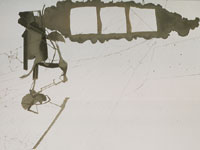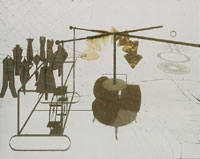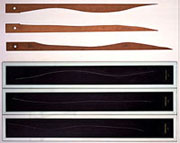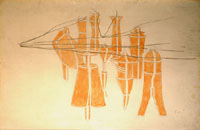Complexity Art by Roberto Giunti |
||||||||||||||||||||||||||||||||||||||||||
|
2. Evolving systems Before the twentieth century it was physics, not biology, that was the leading area of scientific endeavour. It was from physics that models and protocols for science were drawn. The 1900s saw a shift towards biology. This shift was consistent with the progressive affirmation of the new paradigm of complexity. This interest in biology is reflected in the work of Klee, Duchamp and Escher. Firstly Klee, whose interest in Natural History (especially in botany) is well known; like a naturalist he focused (as both artist and teacher) on the central problem of organic growth. He investigated both morphology (the study of forms) and morphogenesis (the study of processes leading to form); his intuitive, biological investigations are notable. Escher, for his part, was more attracted by abstract ideas; more mathematical than biological, but was nonetheless intrigued by the natural world. He dealt especially with the inanimate world of minerals and crystals. However biologists drew analogies of his abstract ideas with corresponding biological concepts; sometimes Escher dealt with biological processes themselves.
Perhaps Duchamp is the artist who best expressed (both in advance and inadvertently) the inversion of the relationship between biology and physics: by distending the laws of physics and chemistry he bypassed the rigid determinism and the reductionism of those disciplines. By grafting the organic forms of the Bride (in the higher part of the Glass) (Fig. 3) onto the mechanical machinery of the Bachelors (in the lower part) (Fig. 4) Duchamp not only expressed the idea of a marriage between physics and chemistry (at the bottom, in a three dimensional world), and biology, (above, in a four dimensional world) but perhaps even the superiority of the latter: after all the bride is queen. This new kind of interest in biology is related to the development in every scientific field of systemic theories. This began in the 1940’s with cybernetics and ended up with the establishment of complexity sciences: what better paradigm of a system is there than an organism? Biology teaches us that complex systems adapt and evolve, we call them complex adaptive systems (CAS) Adaptation and evolution are key in all areas of the complexity sciences. Can artists, that were aware of world-system complexity, have been unaware of these notions of adaptation and evolution, at least at some intuitive level? In my opinion no. Being sensitive to complexity implies having some awareness of evolutionary processes (not necessarily biological), driven by random probabilistic events coupled with adaptation, which make the world-system ever changing. In Klees’ writings we find a number of references to evolutionary biology (6). He clearly had some understanding of the subject matter. However, it is what he did as a painter, more than what he thought as a naturalist, that is interesting here. He would lovingly cultivate mistakes he made, and embed them in his paintings. He would encourage pupils to draw with their left hand, and to nurture the irregularities that ensued. He also would introduce subtle and repeated variations into his work that would form mobile, ever changing patterns. Klee clearly loved chance.
Here, two of Klees’ groups of work are of note: those of Red fugue (1921) (Fig. 5) and Sheet from the town book (1928) (Fig. 6). Both groups are based on repetitive horizontal sequences, which are gradually transformed by introducing constant, apparently random variation in the repetitions of the starting shape. The representation of an evolutionary process could be seen in these paintings, where random mutations seem to be somehow selected to obtain certain properties of the resulting patterns. I discussed the subject in some detail in the article already cited (7), and I showed by means of computer simulations that evolutionary algorithms can produce quite similar patterns. Let us consider now Escher’s use of tessellation or tiling (i.e. covering of the surface by means of repeated tiles, without empty gaps and overlapping), such as the one signed E15 (1938) (Fig. 7). Each single piece of tiling contains the complete information necessary to build the whole surface; of course this holds
Interestingly,
Escher’s tiling often depicts a process which gradually transforms the
structure of the tiles. This transformation is rendered infinite by
the introduction of a circular narrative pattern, which leads it back
to its starting point. The strips named Metamorphosis (the process
which turns the larva into insect) are examples of this (Fig.
8) which Escher created in the late 30’s. Such transformation
can be seen to some extent as a metaphor for evolutionary process. This,
at least, was the opinion of Nobel chemist Melvin Calvin on Escher’s
Verbum (1942) (Fig. 9) (9). Let us thirdly consider Duchamp. The theme of the dichotomy mother - egg, and the paradoxes that lie therein are worthy of investigation. I discussed the subject in the already cited article (10). Duchamp used objects
and moulds to signify the idea of mother and egg. The mould represents
the egg, the object the mother. He used these in a number of different
contexts, including the Malic Moulds of the Glass. (Fig.
10) The object and the mould are self-perpetuating and codependent
: the object is used to cast the mould and the mould to shape the object.
Similar ideas are identifiable in Three Standard Stoppages (1913-14)
(Fig. 11) and Tu m’ (1918) (Fig.
12). For the latter he made three wooden templates, for transferring
the outline of the threads contained in the Stoppages onto the
oil painting. In Tu m’ these templates appear again, depicted
in the bottom-left corner; their respective threads in the right hand
corner. We have the old threads; their templates, and the new threads…
The two elements (thread-Mother and template-Egg) are present in both
the Stoppages and Tu m’. (En passant: notice that
in Tu m’ the representations of templates and threads stand at
the opposite sides of the picture, as we said above; in the middle,
the psychological epopee of Bride and Bachelor is abridged, maybe as
the necessary step to link egg and offspring).
Now the key question is: is this chain deterministic? Could this cyclic process repeat itself unchanged, giving rise to ever equal objects? It couldn’t. Indeed, remember that Duchamp explicitly connects the idea of mould with the idea of infra-thin difference:
Infra-thin separation. 2 forms cast in the same mould (?) differ from each other by an infra thin separative amount. All “identical” as identical as they can be, (and the more identical they are) move toward this infra thin separative difference. (Note posthume). Thus the process contains an important random event (possibly corresponding to biological mutation). A parallel could be drawn between evolutionary process and the cyclical alternation of the object and the mould(Mother-Egg). At the very least, this observation would be consistent with Shearer’s idea [rrs2] that the cemetery of liveries (Fig. 13) (the Malic Moulds) could be seen as the place where scientific knowledge is recorded (11). An empty livery is a repository for a scientific idea as well as being a mould that produces new ideas on which are encoded new theories, thence new liveries and so on. >>Next Notes
Figs.
3-4, 10-13
|
||||||||||||||||||||||||||||||||||||||||||























